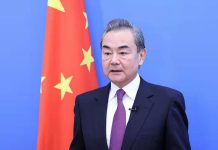BEIJING: As the impacts of the novel coronavirus disease (COVID-19) gradually ease in China, the tide is turning for foreign trade, with production rebounding and work resumption accelerating in recent months. According to data released by the General Administration of Customs of China (GACC), foreign trade in goods totaled 25.95 trillion yuan ($3.91 trillion) in the first 10 months of the year. This represented a year-on-year increase of 1.1 percent, compared with 0.7 percent in the first three quarters.
The recovery was the result of a portfolio of new measures to support foreign trade firms, including enhanced credit services, simplified customs clearance procedures for cross-border e-commerce imports and exports, and eased market access for foreign investment.
Many foreign trade enterprises, especially small and medium-sized ones, were hampered by a shortage of funds. In response, the Ministry of Commerce has increased the export tax refund rate for 1,464 products. Li Xingqian, Director of the Foreign Trade Department at the ministry, told a press conference in early November that the resulting reduction in operation costs has benefited around 25,000 enterprises.
In order to drive up exports, GACC established 10 cross-border business-to-business (B2B) export supervision pilot zones on July 1, integrating customs operations for B2B exports of goods.
In September, 12 more such zones were inaugurated.
Overall growth: GACC data showed that general trade, trading in goods by companies with licenses to import and export, went up 2.8 percent to 15.6 trillion yuan ($2.35 trillion) in the first 10 months of the year, contributing to around 60 percent of the overall trade volume. Imports and exports of private companies expanded 10.5 percent to 12 trillion yuan ($1.8 trillion), accounting for 46.2 percent of the national total, up 4 percentage points compared with the previous year. The Association of Southeast Asian Nations remained China’s largest trading partner during the period, followed by the EU and the United States.
According to Assistant Minister of Commerce Ren Hongbin, COVID-19 prevention and control supplies and essential consumer products for lockdown life boosted China’s exports in the first 10 months. Although auto exports slipped 6.7 percent in the January-October period, the export volume of mechanical and electrical products reached 8.45 trillion yuan ($1.2 trillion), up 3.8 percent. Textile exports including masks also rose 34.8 percent. In the first 10 months, imports and exports of foreign-funded firms reached 10.02 trillion yuan ($1.51 trillion), accounting for 38.6 percent of the overall trade volume. The recovery of business activities also shored up imports. On November 3, the government announced the establishment of 10 demonstration zones with more flexible regulatory systems and trade modes to boost imports. Cross-border e-commerce helped foreign trade companies expand their consumer base at home and abroad. Imports and exports through the cross-border
e-commerce management platform of the Customs reached 187.39 billion yuan ($28.03 billion) in the first three quarters, a year-on-year increase of 52.8 percent.
On November 9, the State Council released a set of guidelines on the innovative development of foreign trade.
The guidelines encourage enterprises to tap into the global market in order to better meet domestic demand, stressing that efforts are needed to raise the competitiveness of foreign trade firms through innovative technologies, rules and business modes. They also specify measures including applying technologies to integrate online and offline business expos, improving rules to facilitate imports and exports of key products, boosting pilot free trade zones and ports, driving cross-border e-commerce through increasing pilot zones and overseas warehouses, and improving services.
According to the document, it is essential to enhance trade quality in the eastern region, improve the proportion of trade in the central and western regions, and expand opening up of the northeastern region for further interregional cooperation.
– The Daily Mail-Beijing Review News exchange item






